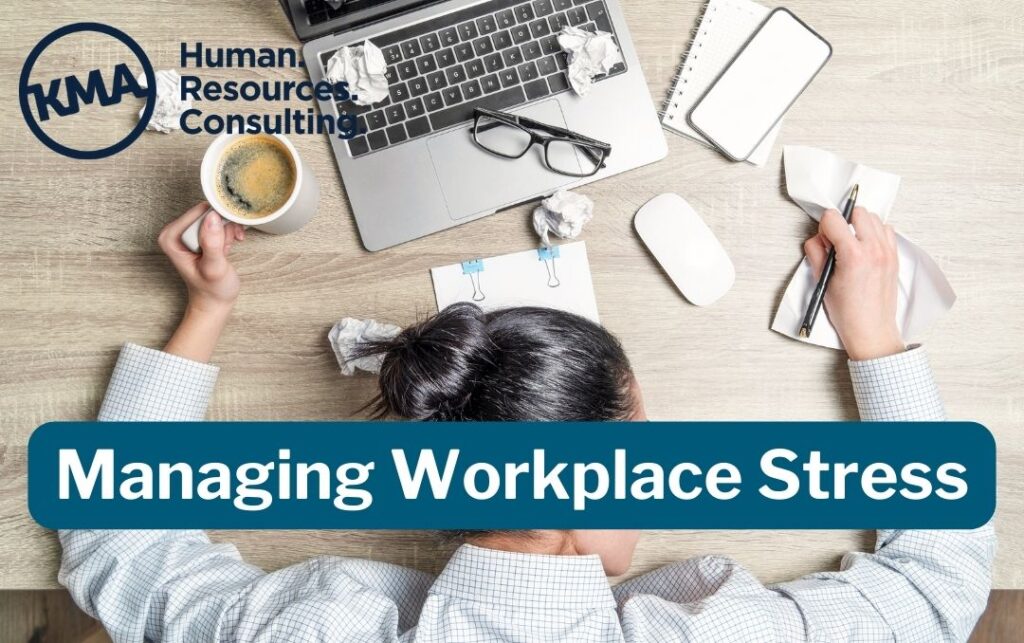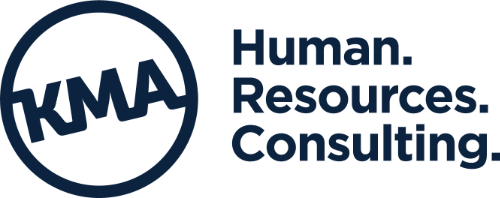 By: The KMA Consulting Team
By: The KMA Consulting Team
According to a recent Gallup survey, the American workforce is among the most stressed globally. While employers cannot control external stressors, they can take steps to manage stress within the organization. Occupational stress influences employee engagement and productivity, so it is crucial that leaders dedicate time to implement proactive and reactive stress-reducing strategies. By investing in the welfare of their staff and providing necessary support, employers can foster a culture of trust and wellbeing for their team.
Workplace stress looks different for every organization and every person. OSHA (Occupational Safety and Health Administration) identifies workplace stress as:
- Concerns about job security (e.g., potential lay-offs, reductions in assigned hours).
- Lack of access to the tools and equipment needed to perform work safely.
- Fear of employer retaliation.
- Facing confrontation from customers, patients, co-workers, supervisors, or employers.
- Adapting to new or different workspace and schedule or work rules.
- Having to learn new or different tasks or take on more responsibilities.
- Having to work more frequent or extended shifts or being unable to take adequate breaks.
- Physically demanding work.
- Learning new communication tools and dealing with technical difficulties.
- Blurring of work-life boundaries, making it hard for workers to disconnect from the office.
- Finding ways to work while simultaneously caring for children, including overseeing online schooling or juggling other caregiving responsibilities.
- Concerns about work performance and productivity.
- Concerns about the safety of using public transit as a commuting option.
How stressed is your team?
Organizations inevitably experience periods of flux, from staff turnover to market shifts and evolving business tactics. All of this can add to the stress of a normal workday and can affect the culture of an organization.
To effectively gauge whether your employees are experiencing stress at work, simply ask them! Survey your employees on their favorite part about their workday and what are the most significant challenges they face. This can serve as a benchmark as you implement initiatives that alleviate workplace-related stress and offer adequate support for your team.
Design Your Workflow to Reduce Burnout
Continuously working without taking meaningful breaks, overloading tasks, and unclear expectations can all contribute to feeling burned out. During individual and team meetings, communicate clearly which tasks take priority over others and set reasonable deadlines. For some teams, delegating tasks based on skill level and workload can prevent individuals from getting overwhelmed. When employees have a clear understanding of what is expected of them, there is less room for imposter syndrome to creep in. Check in with each employee separately and regularly to evaluate their workload.
More Than Just the Metrics
Product output, time to delivery, and customer satisfaction are all measurable, but none of these provide insights into the well-being of your employees. Are there regular opportunities for employees to share new ideas and suggestions? Is a healthy work-life balance encouraged? How accessible is support and guidance for employees when conflicts arise? Explore other metrics to evaluate the success of your team. Performance expectations should be flexible enough to accommodate individuals to operate at a reasonable pace, recognizing that energy levels fluctuate daily.
Perfectionism can also lead to workplace stress. When productivity is linked to self-worth, the impact of a minor slip up is amplified. Let your team know that it is normal (and human) to make mistakes and create an opportunity for learning instead of retaliation.
The Power of Flexibility
Offering flexibility extends beyond remote work. Allowing employees to adjust their schedules to attend to personal commitments, such as leaving early so they can pick up their child from daycare, attending appointments, or going to an important event, can alleviate the burden of a constricted schedule. Numerous studies have shown that flexibility is one of the most desired benefits when looking for or deciding to stay in a position.
Of course, flexibility must be offered within reason and may not be appropriate for all positions and teams. For example, maybe you allow someone to come in at 7 a.m. and leave at 3 p.m. instead of the typical 9-to-5 schedule. Empowering your employees with a sense of choice and flexibility can reduce the burden of external and internal stressors.
The mental wellness of your staff should be the top priority when assessing the overall health of the organization. As a leader, you can’t be held responsible for all the stress your employees may experience, but implementing strategies and proactive measures to alleviate controllable stressors will enhance your company’s work environment, and might be the key to unlocking peak productivity for your team.
Recognize and Reward
Employee appreciation can mitigate certain aspects of organizational stress and provide an overall sense of wellbeing. Recognizing your staff can also serve as a motivational tool when times are tough and remember that rewards don’t always need to be monetary. Taking a moment to recognize an employee at a team meeting, or mentioning a project well-done can go a long way for someone who is feeling stressed.
After all, your most important resource is your people, and the team at KMA is at the ready for all your people-related questions. If you suspect your current compensation and benefits strategy might be part of the issue, reach out to KMA today and let our HR experts take the guesswork out of rewarding your employees appropriately and fairly.
